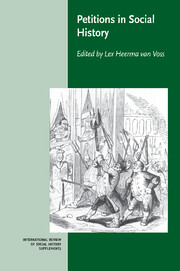Book contents
- Frontmatter
- Contents
- NOTES ON CONTRIBUTORS
- Introduction
- Voices from Among the “Silent Masses”: Humble Petitions and Social Conflicts in Early Modern Central Europe
- Supplications between Politics and Justice: The Northern and Central Italian States in the Early Modern Age
- The Power of Petitions: Women and the New Hampshire Provincial Government, 1695–1700
- Officially Solicited Petitions: The Cahiers de Doléances as a Historical Source
- Revolt, Testimony, Petition: Artisanal Protests in Colonial Andhra
- Deference and Defiance: The Changing Nature of Petitioning in British Naval Dockyards
- Petitions and the Social Context of Political Mobilization in the Revolution of 1848/49: A Microhistorical Actor-Centered Network Analysis
- The Image of Jews in Byelorussia: Petitions as a Source for Popular Consciousness in the Early Twentieth Century
- “Begging the Sages of the Party-State”: Citizenship and Government in Transition in Nationalist China, 1927–1937
- Private Matters: Family and Race and the Post-World-War-II Translation of “American”
Introduction
Published online by Cambridge University Press: 04 August 2010
- Frontmatter
- Contents
- NOTES ON CONTRIBUTORS
- Introduction
- Voices from Among the “Silent Masses”: Humble Petitions and Social Conflicts in Early Modern Central Europe
- Supplications between Politics and Justice: The Northern and Central Italian States in the Early Modern Age
- The Power of Petitions: Women and the New Hampshire Provincial Government, 1695–1700
- Officially Solicited Petitions: The Cahiers de Doléances as a Historical Source
- Revolt, Testimony, Petition: Artisanal Protests in Colonial Andhra
- Deference and Defiance: The Changing Nature of Petitioning in British Naval Dockyards
- Petitions and the Social Context of Political Mobilization in the Revolution of 1848/49: A Microhistorical Actor-Centered Network Analysis
- The Image of Jews in Byelorussia: Petitions as a Source for Popular Consciousness in the Early Twentieth Century
- “Begging the Sages of the Party-State”: Citizenship and Government in Transition in Nationalist China, 1927–1937
- Private Matters: Family and Race and the Post-World-War-II Translation of “American”
Summary
On 31 December 1870, the Swiss philosopher, Henri-Frédéric Amiel (1821–1881), petitioned the municipal authorities of Geneva on behalf of his neighbours and himself. They lived in a street called the Rue des Belles Filles (“beautiful girls' street”) and wanted to have the name of their street changed because it alluded to prostitutes. This is just one among a multitude of historical facts that have come down to us because humble (or not so humble) suppliants put them on paper in the form of a petition, and the authorities to which these petitions were addressed took care to preserve them. Writing petitions was a common human experience. “Everybody is free to write petitions and have a drink of water”, as a traditional German saying would have it. However, as opposed to drinking water, writing petitions is an act which produces historical sources, many of which have survived. The aim of this volume is to give an overview of their importance as sources for social history.
PETITIONS
Petitions are demands for a favour, or for the redressing of an injustice, directed to some established authority. As the distribution of justice and largesse are important parts of ruling, rulers can hardly deny their subjects the right to approach them to implore them to exercise justice, or to grant a favour.
- Type
- Chapter
- Information
- Petitions in Social History , pp. 1 - 10Publisher: Cambridge University PressPrint publication year: 2002
- 5
- Cited by



